List of slums – Wikipedia
From Wikipedia, the free encyclopedia
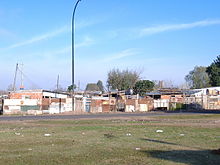

This is a list of slums. A slum as defined by the United Nations agency UN-Habitat, is a run-down area of a city characterized by substandard housing, squalor, and lacking in tenure security. According to the United Nations, the percentage of urban dwellers living in slums decreased from 47 percent to 37 percent in the developing world between 1990 and 2005.[1] However, due to rising population, and the rise especially in urban populations, the number of slum dwellers is rising. One billion people worldwide live in slums[2] and the figure is projected to grow to 2 billion by 2030.[3]
Egypt[edit]
Ghana[edit]

Kenya[edit]

Liberia[edit]
Mauritania[edit]
Namibia[edit]
Nigeria[edit]
South Africa[edit]
Spain[edit]
Bangladesh[edit]
- Begun Bari[14]
- Bhola (Dhaka North)
- City Palli (Dhaka South)
- Driver Colony (Dhaka South)
- Duaripara (Dhaka North)
- Kawnia
- Korail slum (Dhaka North)
- Lalbagh (Slum)|Lalbagh
- Mach Colony
- Mannan (Dhaka South)
- Mohammadpur (Slum)|Mohammadpur
- Molla (Dhaka North)
- Monsur Beel / Nama Para
- Mymensingh (Slum)|Mymensingh
- Nubur (Dhaka South)
- Power House (Dhaka South)
- Pura (Dhaka South)
- Rail Line Slums (most of the largest rail lines in Bangladesh have slums)
Hong Kong[edit]
India[edit]
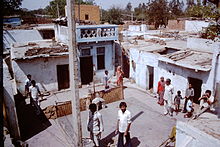
- Kirti Nagar, Delhi, Delhi
- Munirka, Delhi, Delhi
- Kathputhli Colony, Delhi
- Talkatora, Delhi
- Pilkhana, Kolkata
- Tikiapara, Kolkata
- Basanti, Kolkata
- Chandmari, Guwahati
- Dharavi, Mumbai
- Banganga, Mumbai
- Baiganwadi, Mumbai
- Antop Hill, Mumbai
- Vyasarpadi, Chennai
- Royapuram, Chennai
- Thiruvotriyur, Chennai
- Salia Sahi, Bhubaneswar[15]
Pakistan[edit]

- Parts of Machar Colony[16]
Previous Slums in Pakistan[edit]
- Orangi, previously but status changed to municipality from 2018 onward.
South Korea[edit]
Sri Lanka[edit]
Turkey[edit]
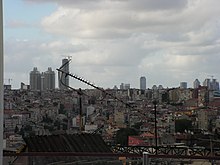
- Sultanbeyli, Istanbul
- Çinçin, one of the most popular Turkish gecekondu (slum) located in Ankara
- Hacıhüsrev, largest slum of İstanbul
- Hürriyet mahallesi, Adana
- Kadifekale, Izmir
- Horozköy, Manisa
Yemen[edit]
Oceania[edit]
Australia[edit]
- Little Lon district – In the nineteenth century the area consisted of timber and brick cottages, shops and small factories and was home to an ethnically diverse and generally poor population. Today there are few reminders of the area’s former notoriety.
Europe (formerly)[edit]
The following are former slum areas that have subsequently been either gradually developed or abruptly cleared and demolished.
Bulgaria[edit]
Greece[edit]
Agia Kyriaki, Acharnes, Athens
Ano Liosia, Athens
Dendropotamos, Thessaloniki
Kountiuriotika, Athens
Nea zoi, Aspropyrgos, Attica
Neos Kosmos, Athens
Perama, Piraeus
Italy[edit]
Malta[edit]

- The Manderaggio, an area in Valletta that was a slum area from the 16th to 20th centuries. It was demolished in the 1950s and replaced by housing estates.
Spain[edit]
Portugal[edit]
Serbia[edit]

North America[edit]



Bahamas[edit]
- Over The Hill it is the largest and most populous of the Bahamas with about 2.5 km2
Haiti[edit]
Jamaica[edit]
Mexico[edit]
Puerto Rico[edit]
South America[edit]
Argentina[edit]

In Buenos Aires:
Brazil[edit]
Shanty towns in Brazil are referred to as favelas.

Colombia[edit]
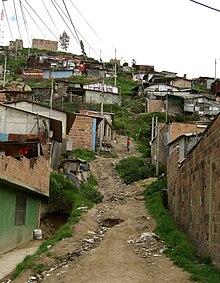
Paraguay[edit]
Peru[edit]
Pueblos jóvenes is the nickname given to the vast shanty towns that surround Lima and other cities of Peru. Many of these towns have developed into significant districts in Lima such as Villa El Salvador and Comas District, Lima.
Uruguay[edit]
Venezuela[edit]
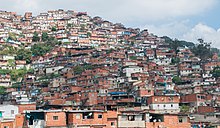
See also[edit]

References[edit]
- ^ United Nations, 2007. The Millennium Development Goals Report. p. 26
- ^ “Review of Mike Davis’ ‘Planet of Slums’“. The Struggle for the City. Archived from the original on 5 October 2011. Retrieved 30 April 2016.
- ^ Slum Dwellers to double by 2030 Archived 2013-03-17 at the Wayback Machine UN-HABITAT report, April 2007.
- ^ Zimring, Carl A.; Rathje, William L. (29 February 2012). Encyclopedia of Consumption and Waste. ISBN 9781412988193. Retrieved 30 April 2016.
- ^ “The Challenge of Slums”. 2003. Retrieved 30 April 2016.
- ^ Grant, Richard (28 February 2009). Globalizing City. ISBN 9780815631729. Retrieved 30 April 2016.
- ^ “Kenya National Assembly Official Record (Hansard)”. 28 October 2010. Retrieved 30 April 2016.
- ^ Syrjanen, Raakel (2008). UN-Habitat and the Kenya slum upgrading programme. ISBN 9789211319903. Retrieved 30 April 2016.
- ^ “Mapping for better healthcare in Nairobi’s slums”. CIMSpatial group at the Centre of Interdisciplinary Methodologies (CIM), University of Warwick, UK. Retrieved 10 July 2018.
- ^ Mason, Paul (2010). Live Working Or Die Fighting. ISBN 9781608460700. Retrieved 30 April 2016.
- ^ a b Dodman, David; Bicknell, Jane; Satterthwaite, David (31 May 2012). Adapting Cities to Climate Change. ISBN 9781136572531. Retrieved 30 April 2016.
- ^ Global Politics in a Changing World. 2009. ISBN 9780618974511. Retrieved 30 April 2016.
- ^ Kok, Pieter (1998). South Africa’s Magnifying Glass. ISBN 9780796918796. Retrieved 30 April 2016.
- ^ Ramesh, Randeep (22 December 2006). “Hidden cost of ‘cheap chic’“. The Guardian. London. Retrieved 2008-11-24.
- ^ http://bmc.gov.in/Download/BMC%20Slums.pdf[bare URL PDF]
- ^ “Demolishing Slums”. The Nation. 2015-07-12. Retrieved 2018-07-10.
- ^ demolished/undergoing demolition
- ^ [1] “What Is Urban Upgrading?” MIT. Accessed 3 December 2010
External links[edit]
![]() Media related to Slums at Wikimedia Commons
Media related to Slums at Wikimedia Commons
Recent Comments